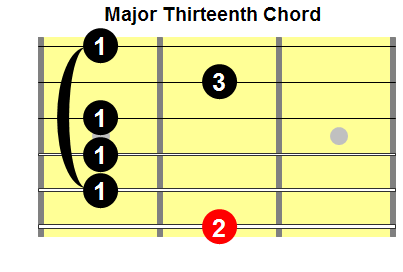An extended chord is a seventh chord to which an extension note — the ninth, 11th or 13th degree of the major scale — is added.
A thirteenth chord — as the name suggests — is a seventh chord to which the 13th scale degree is added.
This post will cover how to construct thirteenth chords and provide examples for each type of chord.
It will also provide common fingerings for each chord, along with instruction on how to play them on a guitar with any root note.
Identifying the 13th Scale Degree
An extended C major scale with the scale degrees labeled is shown in fig.1.
As you can see, the 13th degree of a major scale is the same note as the fourth degree, an octave higher. In a C major scale, the 13th scale degree is A.
Fig.1

Major Thirteenth Chords
The chord formula for a major thirteenth chord is: 1, 3, 5, 7, 9, 11, 13.
A major thirteenth chord contains the first, third, fifth, seventh, ninth, 11th and 13th degrees of the major scale with the same root note.
For example, a Cmaj13 chord contains the notes C, E, G, B, D, F and A — the first, third, fifth, seventh, ninth, 11th and 13th notes in a C major scale (fig.2a).
In Practice
In practice, the 11th scale degree is almost always omitted from a major thirteenth chord because it tends to clash with the chord’s third and seventh scale degrees.
Dominant Thirteenth Chords
The chord formula for a dominant thirteenth chord is: 1, 3, 5, b7, 9, 11, 13.
A dominant thirteenth chord contains the first, third, fifth, flatted seventh, ninth, 11th and 13th degrees of the major scale with the same root note.
A C13 chord contains the notes C, E, G, Bb, D, F and A — the first, third, fifth, flatted seventh, ninth, 11th and 13th notes in a C major scale (fig.2b).
In Practice
In practice the 11th scale degree is almost always omitted from a dominant thirteenth chord because it tends to clash with the chord’s third scale degree.
Minor Thirteenth Chords
The chord formula for a minor thirteenth chord is: 1, b3, 5, b7, 9, 11, 13.
A minor thirteenth chord contains the first, flatted third, fifth, flatted seventh, ninth, 11th and 13th degrees of the major scale with the same root note.
A Cm13 chord contains the notes C, Eb, G, Bb, D, F and A — the first, flatted third, fifth, flatted seventh, ninth, 11th and 13th notes in a C major scale.
Fig.2

Summary of Thirteenth Chord Formulas
The thirteenth chord formulas covered in this post are summarized below:
- Major thirteenth: 1, 3, 5, 7, 9, 11, 13.
- Dominant thirteenth: 1, 3, 5, b7, 9, 11, 13.
- Minor thirteenth: 1, b3, 5, b7, 9, 11, 13.
Thirteenth Chords Built on All 12 Root Notes
The thirteenth chords built on all 12 root notes are shown in fig.3.
Fig.3



Omitted Notes
All of the notes in an extended chord formula don’t necessarily have to be included in any particular chord voicing. Some notes are less important than others and can be omitted.
The important notes that should always be included in an extended chord voicing are the chord’s third and seventh degrees and the highest extension note (the 13th scale degree for thirteenth chords).
Root notes, the fifth scale degree and other extension notes are routinely left out of extended chord voicings on a guitar.
Thirteenth Chords on a Guitar
Major Thirteenth Chords
A common fingering for a major thirteenth chord is shown in fig.4.
Fig.4

This fingering will allow you to play a major thirteenth chord with any root note:
- To play a Cmaj13, place the barre on the seventh fret (fig.5a).
- To play an Emaj13, place the barre on the 11th fret (fig.5b).
Fig.5

Dominant Thirteenth Chords
A common fingering for a dominant thirteenth chord is shown in fig.6.
Fig.6

This fingering will allow you to play a dominant thirteenth chord with any root note:
- To play a C13, place the barre on the eighth fret (fig.7a).
- To play an E13, place the barre on the 12th fret (fig.7b).
Fig.7

Minor Thirteenth Chords
A common fingering for a minor thirteenth chord is shown in fig.8.
Fig.8

This fingering will allow you to play a minor thirteenth chord with any root note:
- To play a Cm13, place the barre on the eighth fret (fig.9a).
- To play an Em13, place the barre on the 12th fret (fig.9b).
Fig.9

Chord Quality and Harmonic Function
The extension notes add color, texture and complexity to the seventh chords to which they are added. They don’t change the chord’s quality or harmonic function.
For example, the chords C7 and C13 are both dominant chords and both primarily function as the V chord in the key of F major.
Application
Thirteenth chords are commonly substituted for seventh chords, especially in blues and jazz chord progressions.
Related Posts
Related posts include:
